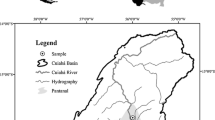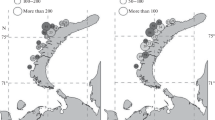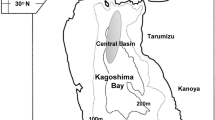Abstract
Population of the freshwater amphipod Gammarus fossarum was investigated in a calcareous stream with almost constant temperature (7–8°C) in the Chočské Vrchy Mts (West Carpathians, Slovakia). Quantitative samples of G. fossarum taken during 2005 showed population densities varying from 100 m−2 in August to 585 m−2 in late November. The population was split into juveniles, mature males, mature females without eggs and females with eggs. The percentage of juveniles (40–64%) was always the highest of any of the categories. Ovigerous females occurred throughout the year. The mean sex ratio was 1: 2.4 (male: female), although its values varied considerably with the time of year. Breeding was continuous, although juvenile recruitment peaked in early spring, summer and early winter. Three discrete cohorts were distinguished from the size frequency distributions. The life span was 6–7 months and the individuals matured approximately in the half of life cycle. The mean fecundity was 9.6 embryos per brood. Variation in fecundity was mostly explained by size of the incubating females. The absolute growth of this species was best described by the Gompertz growth function. Relative growth rates (% body DM day−1) fluctuated in a nonlinear manner with size and age. The highest values of daily growth (2–4% of dry mass per day) were noted approximately in the half of life cycle. Annual production, estimated by the size-frequency method, was 1618.9 g dry mass m−2 and P/B ratio was 5.15.
Similar content being viewed by others
References
Benke A.C. 1979. A modification of the Hynes method for estimating secondary production with particular significance for multivoltine populations. Limnol. Oceanogr. 24(1): 168–171.
Beracko P. 2007. Bionomia pijavice Dina punctata (Johansson, 1927) v podhorskej časti potoka Vydrica [Bionomy of leech Dina punctata (Johansson, 1927) in submontane stretch of Vydrica stream]. Rigorozna praca, Prif.UK [M.Sc. Thesis, Faculty of Natural Sciences, Comenius University], Bratislava, 69 pp.
Bulnheim H.P. 1972. Vergleichende Untersuchungen zur Atmungsphysiologie euryhaliner Gammariden unter besonderer Berücksichtigung der Salzehaltsanpassung. Helgoland Marine Research 23(4): 485–534. DOI: 10.1007/BF01625297
Burgherr P. & Meyer E. 1997. Regression analysis of linear body dimensions vs. dry mass in stream macroinvertebrates. Arch. Hydrobiol. 139(1): 101–112.
Dangles O. & Guerold F. 2000. Feeding activity of Gammarus fossarum (Crustacea: Amphipoda) in acidic and low mineralised streams. Verh. Int. Verein. Limnol. 27: 1–4.
Davis C.C. 1981. Mechanisms of hatching in aquatic invertebrate eggs II, pp. 95–123. In: Barnes H., Ansell A.D. & Gibson R.N. (eds), Oceanography and Marine Biology: An Annual Review 19, 656 pp. ISBN: 0080284396
D’Cotta H., Fostier A., Guiguen Y., Govoroun M. & Baroiller J.F. 2001. Search for the molecular mechanisms implicated in the thermosensitivity of sex gonadal differentiation of tilapia fish: differential approach and expression of candidate genes. J. Exp. Zool. 290: 574–585. DOI: 10.1002/jez.1108
de March B.G.E. 1981. Gammarus lacustris, pp. 79–94. In: Lawrence S.G. (ed.), Manual for the Culture of Selected Freshwater Invertebrates, Can. Spec. Publ. Fish. Aquat. Sci. 54, 169 pp. ISBN: 0662114485, 9780662114482
Dunn A.M., Hogg J.C., Kelly, A. & Hatcher M.J. 2005. Two cues for sex determination in Gammarus duebeni: Adaptive variation in environmental sex determination? Limnol. Oceanogr. 50(1): 346–353. DOI: 10.4319/lo.2005.50.1.0346
Goedmakers A. 1980. Population dynamics of three gammarid species (Crustacea, Amphipoda) in a French chalk stream. Part I. General aspects and environmental factors. Bijdragen Tot de Dierkunde 50: 1–34.
Goedmakers A. 1981. Population dynamics of three gammarid species (Crustacea, Amphipoda) in a French chalk stream. Part II. Standing crop. Bijdragen Tot de Dierkunde 51(1): 31–69.
Griffith M.B., Perry S.A. & Perry W.B. 1994. Secondary production of macroinvertebrate shredders in headwater streams with different baseflow alkalinity. J. North Amer. Benthol. Soc. 13(3): 345–356.
Gruner H.E. 1993. Klasse Crustacea, pp. 448–1030. In: Gruner H.E., Moritz M. & Dunger W. (eds), Lehrbuch der speziellen Zoologie (begr. von A. Kaestner), Wirbellose Tiere, 4. Teil: Arthropoda (ohne Insecta), Gustav Fischer, Jena. ISBN: 3-334-60404-7
Guiguen J.F., Baroiller M.J., Ricordel M.J., Iseki K., Mcmeel O.M., Martin S.A. & Fostier A. 1999. Involvement of estrogens in the process of sex differentiation in two fish species: the rainbow trout (Oncorhynchus mykiss) and a tilapia (Oreochromis niloticus). Mol. Reprod. Dev. 54(2): 154–162. PMID: 10471475
Haley C.J. 1997. Comparisons of Secondary Production, Life History, and Mouthpart Functional Morphology between two Populations of the Amphipod Gammarus minus. Ph.D. Thesis, Faculty of the Virginia Polytechnic Institute and State University, Blacksburg, 88 pp.
Helan J., Kubiček F., Losos B., Sedlak E. & Zelinka M. 1973. Production conditions in the trout brooks of the Beskydy Mountains. Folia Fac. Sci. Nat. Univ. Purkynianae Brunensis, Biol. 38, 14(4): 1–105.
Iversen T.M. & Jessen J. 1977. Life-cycle, drift and production of Gammarus pulex L. (Amphipoda) in a Danish spring. Freshwater Biol. 7(3): 287–296. DOI: 10.1111/j.1365-2427.1977.tb01676.x
Kneib R.T., Newell S.Y. & Hermeno H.T. 1997. Survival, growth and reproduction of the salt-marsh amphipod Uhlorchestia spartinophila reared on natural diets of senescent and dead Spartina alterniflora leaves. Mar. Biol. 128(3): 423–431. DOI: 10.1007/s002270050108
Kolding S. & Fenchel T M. 1979. Coexistence and life cycle characteristics of five species of the amphipod genus Gammarus. Oikos 33(2): 323–327.
Kozačekova Z., Tierno de Figueroa J. M., Lopez-Rodriguez M. J., Beracko P. & Derka T. 2009. Life history of a population of Protonemura intricata (RIS, 1902) (Insecta, Plecoptera) in a constant temperature stream in Central Europe. Int. Rev. Hydrobiol. 94(1): 57–66. DOI: 10.1002/iroh.200811101
Ladewig V., Jungmann D., Köhler H.R., Schirling M., Triebskorn R. & Nagel R. 2006. Population structure and dynamics of Gammarus fossarum (Amphipoda) upstream and downstream from effluents of sewage treatment plants. Arch. Environ, Contamin. Toxicol. 50(3): 370–383 DOI: 10.1007/s00244-005-7039-0
Maranhão P., Bengala N., Pardal M. & Marques J.C. 2001. The influence of environmental factors on the population dynamics, reproductive biology and productivity of Echinogammarus marinus Leach (Amphipoda, Gammaridae) in the Mondego estuary (Portugal). Acta Oecol. 22: 1–14. DOI: 10.1016/S1146-609X(01)01112-2
Maranhão P. & Marques J.C. 2003. The influence of temperature and salinity on the duration of embryonic development, fecundity and growth of the amphipod Echinogammarus marinus Leach (Gammaridae). Acta Oecol. 24(1): 5–3. DOI: 10.1016/S1146-609X(02)00003-6
Marten M. & Zwick P. 1981. The temperature dependence of embryonic and larval development in Protonemura intricata (Plecoptera: Nemouridae). Freshwater Biol. 22(1): 1–14. DOI: 10.1111/j.1365-2427.1989.tb01079.x
Mohammadi G.H., Khodadadi M., Nasr A. & Safikhani H. 2010. Fecundity reproductive cycle of a local population of Gammarus pulex in Sepidan (Fars Province, Iran). Austral. J. Basic Appl. Sci. 4(11): 5571–5577.
Obrdlik P. 1972. A population of Rivulogammarus fossarum Koch (Amphipoda) in a small fishless stream. Hydrobiologia 40(2): 279–295. DOI: 10.1007/BF00016798
Pařil P. 2011. Vliv extremnich hydrologickych situaci na strukturu vybranych skupin permanentni a temporarni složky benticke fauny v tocich [The impact of extreme hydrological events on structure of selected groups of temporary and permanent fauna in streams]. Disertačni prace, Přirodovědecka fakulta MU [PhD. Thesis, Faculty of Natural Sciences, Masaryk University], Brno, 150 pp.
Piferrer S., Zanuy M., Carrillo I., Solar R.H., Donaldson D. & Donaldson E.M. 1994. Brief treatment with an aromatase inhibitor during sex differentiation causes chromosomally female salmon to develop as normal functional males. J. Exp. Zool. 270(3): 255–262. DOI: 10.1002/jez.1402700304
Pöckl M. 1992. Effects of temperature, age and body size on moulting and growth in the freshwater amphipods Gammarus fossarum and G. roeseli. Freshwater Biol. 27(2): 211–225. DOI: 10.1111/j.1365-2427.1992.tb00534.x
Pöckl M. 1993. Reproductive potential and lifetime potential fecundity of the freshwater amphipods Gammarus fossarum and G. roeseli in Austrian streams and rivers. Freshwater Biol. 30(1): 73–91. DOI: 10.1111/j.1365-2427.1993.tb00790.x
Pöckl M. 1995. Laboratory studies on growth, feeding, moulting and mortality in the freshwater amphipods Gammarus fossarum and G. roeseli. Arch. Hydrobiol. 134(2): 223–253.
Pöckl M. & Humpesch U.H. 1990. Intra- and inter-specific variations in egg survival and brood development time for Austrian populations of Gammarus fossarum and G. roeseli (Crustacea: Amphipoda). Freshwater Biol. 23(3): 441–455. DOI: 10.1111/j.1365-2427.1990.tb00286.x
Pöckl M., Webb B.W. & Sutcliffe D.W. 2003. Life history and reproductive capacity of Gammarus fossarum and Gammarus roeselii (Crustacea — Amphipoda) under naturally fluctuating water temperatures a simulation study. Freshwater Biol. 48(1): 53–66. DOI: 10.1046/j.1365-2427.2003.00967.x
Prato E. & Biandolino F. 2003. Seasonal changes in population of the Amphipod Gammarus aequicauda (Martynov, 1931). Mediterr. Mar. Sci. 4(1): 49–56.
Roshan A. 2000. Reproduction Biology of Gammarus komarek. M.Sc. Thesis, Isalimic Azad University, Shomal Branch, Tehran, 176 pp.
Simpson E.R., Mahendroo M.S., Means G.D., Kilgore M.W., Hinshelwood M.M., Graham-Lorence S., Amarneh B., Ito Y., Fisher C.R. & Michael M.D. 1994. Aromatase cytochrome P450, the enzyme responsible for estrogen biosynthesis. Endocr. Rev. 15(3): 342–355. DOI: 10.1210/edrv-15-3-342
Stewart K.W. & Stark B.P. 1993. Nymphs of North American Stonefly Genera (Plecoptera). 2nd Ed., Vol. 12. The Thomas Say Foundation, Denton, 460 pp. ISBN: 0938522337
Stürzbecher C., Müller J. & Seitz A. 1999. Coexisting Gammarus fossarum types (Amphipoda) in central Europe: Regular patterns of population dynamics and microdistribution, pp. 287–293. In: Schram F.R. & Vaupel Klein J.C. (eds), Crustaceans and the Biodiversity Crisis: Proceedings of the Fourth Int. Crustacean Congress, Amsterdam, the Netherlands, July 20–24, 1998. ISBN: 9004113878
Sutcliffe D.W. 1992. Reproduction in Gammarus (Crustacea: Amphipoda): basic reproductive processes. Freshwater Forum 2(2): 102–128.
Waters T.F. 1977. Secondary Production in Inland Waters. Advances in Ecological Research. Academic Press, London, pp. 91-164. DOI: 10.1016/S0065-2504(08)60235-4
Watt P.J. 1994. Parental control of sex ratio in Gammarus duebueni, an organism with environmental sex determination. J. Evol. Biol. 7(2): 177–187. DOI: 10.1046/j.1420-9101.1994.7020177.x
Zavadilova V. 2007. Změny habitatovych preferenci druhu Gammarus fossarum v pruběhu vysychani toku. Bc. Thesis, Masarykova univerzita, Brno, 35 pp. IS: /id/3rprph/
Zielinski D. 1998. Life cycle and altitude range of Gammarus leopoliensis Jazdzewski & Konopacka, 1989 (Amphipoda) in south-eastern Poland. Crustaceana 71(2): 129–143. DOI: 10.1163/156854098X00112
Zwick P. 1981. Diapause development of Protonemura intricata (Plecoptera: Nemouridae). Verh. Int. Verein. Limnol. 21: 1607–1611.
Author information
Authors and Affiliations
Corresponding author
Rights and permissions
About this article
Cite this article
Beracko, P., Sýkorová, A. & Štangler, A. Life history, secondary production and population dynamics of Gammarus fossarum (Koch, 1836) in a constant temperature stream. Biologia 67, 164–171 (2012). https://doi.org/10.2478/s11756-011-0148-5
Received:
Accepted:
Published:
Issue Date:
DOI: https://doi.org/10.2478/s11756-011-0148-5




